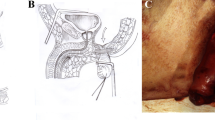Abstract
A report is given on 26 patients (18 men and 8 women) undergoing low anterior resection for carcinoma of the rectum, using both the TA 55 and EEA staplers. The average age was 65 years (range, 45 to 92 years). The preoperative level of the lesion from the anal verge averaged 9.8 cm (range, 4 to 17 cm). All had well-differentiated or moderately well-differentiated lesions. All lesions were removed using the following technique. The TA 55 stapler was placed across the lower rectum at the distal resection margin. The EEA stapler was introduced into the rectum with the anvil removed. The shaft was then passed through the rectum stump either through or immediately adjacent to the staple line. The anvil was refitted and the anastomosis completed between the more proximal colon and the rectal stump. A defunctioning colostomy was employed in only one patient. There has been no mortality. Follow-up has been 2 to 16 months, and there has been no early recurrence. The postoperative level of the anastomosis averaged 5.5 cm (range, 2 to 11 cm). Stapler-related complications occurred in three patients. One of these patients developed a postoperative anastomotic leak, which necessitated a defunctioning colostomy. Two anastomotic strictures occurred following either an anastomotic leak or postoperative radiation therapy. Early incontinence to gas, night-time anal soilage, and urgency occurred in eight patients (30 per cent). These symptoms improved or disappeared within three months following operation. The authors' preliminary experience has shown the double stapling technique to have definite advantages. It obviates the use of lower purse-string suture and permits a lower and easier anastomosis, It avoids the problem of disparity of sizes of the two ends of the bowel. The rectum is not opened and fecal spillage is minimized. To date, results have been good without excessive complications.
Similar content being viewed by others
References
Night D, Griffen FD. An improved technique for low anterior resection of the rectum using the EEA stapler. Surgery 1980; 88:710–4.
Adloff M, Arnaud JP, Beehary S. Stapled vs. sutured colorectal anastomosis. Arch Surg 1980;115:1436–8.
Kirkegaard P, Christiansen J, Hjortrup A. Anterior resection for mid rectal cancer with the EEA stapling instrument. Am J Surg 1980;140:312–4.
Nance FC. New techniques of gastrointestinal anastomoses with the EEA stapler. Ann Surg 1979;189:587–600.
Goligher JC, Lee PW, Macfie J, Simpkins KC, Lintott DJ. Experience with the Russian model 249 suture gun for anastomosis of the rectum. Surg Gynecol Obstet 1979;148:517–24.
Beart RW Jr, Kelly KA. Randomized prospective evaluation of the EEA stapler for colorectal anastomoses. Am J Surg 1981;141: 143–7.
Goligher JC. Use of ciruclar stapling gun with perianal insertion of ano-rectal pursestring suture for construction of very low colorectal or coloanal anastomoses. Br J Surg 1979;66:501–4.
Author information
Authors and Affiliations
Additional information
Read at the meeting of the American Society of Colon and Rectal Surgeons, San Francisco, California, May 2 to 6, 1982.
About this article
Cite this article
Cohen, Z., Myers, E., Langer, B. et al. Double stapling technique for low anterior resection. Dis Colon Rectum 26, 231–235 (1983). https://doi.org/10.1007/BF02562484
Received:
Issue Date:
DOI: https://doi.org/10.1007/BF02562484




